Picture |
Object
name
#NORAD |
Description |
Launch
Date |
Weight |

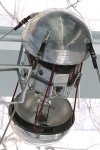

|
Sputnik
1
Sputnik I
#00002
(1957-001B)
(1957 Alpha 2) |
 This
first man made satellite in space was launched by USSR
into an elliptical orbit with an inclination of 65 degrees,
a perigee of 238 km and an apogee of 947 km. Sputnik
1 needed 96,2 minutes to circulate the Earth. This
first man made satellite in space was launched by USSR
into an elliptical orbit with an inclination of 65 degrees,
a perigee of 238 km and an apogee of 947 km. Sputnik
1 needed 96,2 minutes to circulate the Earth.  The
spherical satellite had a diameter of 58cm and carried
2 radio beacons transmitting on 20.005 MHz and 40.010
MHz. The batteries powering the transmitters had a lifetime
of 21 days. Sputnik 1 reentered the Earth's atmosphere
after 92 days and decayed on January 4th
1958. Recording kindly provided by Alois DL3PD/SK. The
spherical satellite had a diameter of 58cm and carried
2 radio beacons transmitting on 20.005 MHz and 40.010
MHz. The batteries powering the transmitters had a lifetime
of 21 days. Sputnik 1 reentered the Earth's atmosphere
after 92 days and decayed on January 4th
1958. Recording kindly provided by Alois DL3PD/SK.
|
Oct
4th 1957 |
83,6
kg |
 On October On October
 6th
1957 around 20:00 UTC Sputnik 1 was received on 20 MHz
by Bayrische Volkssternwarte in Munich. The recording
was kindly provided by Tobias Lindemann and Josef Huber. 6th
1957 around 20:00 UTC Sputnik 1 was received on 20 MHz
by Bayrische Volkssternwarte in Munich. The recording
was kindly provided by Tobias Lindemann and Josef Huber.
|
 This
audio file was recorded by Roy This
audio file was recorded by Roy  W0SL
in Dallas, Texas on October 7th,
1957 at 0457UTC using a military surplus AN/FRR3A HF
RTTY receiver tuned to 20.007 MHz. Thanks Roy for providing
this recording. W0SL
in Dallas, Texas on October 7th,
1957 at 0457UTC using a military surplus AN/FRR3A HF
RTTY receiver tuned to 20.007 MHz. Thanks Roy for providing
this recording.
|
 This
recording is from an unknown German ham-radio amateur.
It was filtered and provided by Don P. Mitchell. This
recording is from an unknown German ham-radio amateur.
It was filtered and provided by Don P. Mitchell.
|
 An unknown
British SWL is commenting the reception of Sputnik 1
on October 11th 1957 at 10:58pm.
The original source of this recording is unknown. The
recording was kindly provided by Bill KA8VIT. (Please
note that this recording is 5MB large). An unknown
British SWL is commenting the reception of Sputnik 1
on October 11th 1957 at 10:58pm.
The original source of this recording is unknown. The
recording was kindly provided by Bill KA8VIT. (Please
note that this recording is 5MB large).
|
 Enclosed
recording of Sputnik 1 is from a radio station in Milwaukee.
The recording is from vinyl no. 1 which was included
in the Italian Enciclopaedia L置omo e lo spazio (The
man and the space) issued 1965 by Fratelli Fabbri. Digitized
and kindly provided by Federico Manzini. Enclosed
recording of Sputnik 1 is from a radio station in Milwaukee.
The recording is from vinyl no. 1 which was included
in the Italian Enciclopaedia L置omo e lo spazio (The
man and the space) issued 1965 by Fratelli Fabbri. Digitized
and kindly provided by Federico Manzini.
|
 This Audio
file was published by NASA and provides various analysis
of the Sputnik 1 radio emissions conducted by Caltech.
Recording courtesy of NASA. This Audio
file was published by NASA and provides various analysis
of the Sputnik 1 radio emissions conducted by Caltech.
Recording courtesy of NASA.
|
  This
Audio file is based on a recording
which was made by a group of young engineering students
at the Fernmeldetechnik Department of TH Darmstadt.
The exact date of the recording on a 80.5 x 3.5 cm paper
strip is unknown. The paper tape was scanned and digitized
and converted into audio using Photoshop for scanning
and Audacity for sound processing. The image shows the
paper strip. Recording kindly provided by Luis Maria
Benitez. This
Audio file is based on a recording
which was made by a group of young engineering students
at the Fernmeldetechnik Department of TH Darmstadt.
The exact date of the recording on a 80.5 x 3.5 cm paper
strip is unknown. The paper tape was scanned and digitized
and converted into audio using Photoshop for scanning
and Audacity for sound processing. The image shows the
paper strip. Recording kindly provided by Luis Maria
Benitez.
|



|
Sputnik
2
Sputnik II
Physical lab
PS 2
#00003
(1957-002A)
(1957 Beta 1) |
 Sputnik
2 was the first spaceship which brought an animal in
space. The elliptical orbit had an apogee of 1770 km
and an apogee of 320 km. Sputnik II circulated the Earth
in 103,7 minutes. Sputnik
2 was the first spaceship which brought an animal in
space. The elliptical orbit had an apogee of 1770 km
and an apogee of 320 km. Sputnik II circulated the Earth
in 103,7 minutes.
Sputnik 2 was a three-part conical
satellite with a hight of 1.2m and was comprised of
the following sections:
- a cylindrical container
for scientific equipment
- a spherical container
for batteries, 2 transmitters and radiotelemetry systems
- a sealed cabin for the a dog named Laika
Laika
lived for one week and part of the downlink telemetry
was her heartbeat. She died on November 10th
1957 when oxygen in her capsule was exhausted.
Sputnik II transmitted for 7 days on the frequencies
20.005 MHz and 40.010 MHz.
Sputnik 2 decayed on
April 14th 1958. This recording
was provided by Alois DL3PD/SK.
|
Nov
3rd 1957 |
508
kg |
 Enclosed
is the recording of the heartbeat of the dog Laika aboard
Sputnik 2. The recording is from vinyl no. 2 which was
included in the Italian Enciclopaedia L置omo e lo spazio
(The man and the space) issued 1965 by Fratelli Fabbri.
Digitized and kindly provided by Federico Manzini. Enclosed
is the recording of the heartbeat of the dog Laika aboard
Sputnik 2. The recording is from vinyl no. 2 which was
included in the Italian Enciclopaedia L置omo e lo spazio
(The man and the space) issued 1965 by Fratelli Fabbri.
Digitized and kindly provided by Federico Manzini.
|
  In June
2010 I received from Dick W4PUJ/SK In June
2010 I received from Dick W4PUJ/SK
(ex WA4DGU) together
with a number of other unique audio recordings enclosed
recording of Sputnik II. Thanks Dick for providing this
recording. Dick became silent key on February 14th
2012.
|

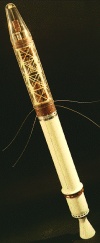

|
Explorer
1
Explorer I
1958 Alpha 1
#00004
(1958-001A) |
Explorer 1 was America's
first orbiting satellite. It was launched from Cape
Canaveral, Florida by an Army Jupiter C four stage rocket
into an elliptical orbit with an inclination of 33,3
degrees, a perigee of 320 km and an apogee of
2735 km. Explorer 1 circulated the Earth in 114,7 minutes.
The cylindrical satellite was 1.5m long and had
a diameter of 15cm. Explorer 1 featured 2 transmitters.
The transmitter on 108,03 MHz had a transmit power of
60 mW and operated 14 days, the transmitter on 108,0
MHz had a transmit power of 10 mW and transmitted until
May 23rd 1958. The transmissions
included information about the satellites temperature,
cosmic rays and micro-meteorites. In the second picture
to the left you can see a mesh of wires around the upper
part of the satellite. This was used to detect micro-meteorites.
Explorer 1 discovered the Van Allen radiation belt.
The batteries lasted about 3 months. Explorer
1 decayed on March 31st 1970. |
Jan
31st
1958 |
13,5
kg |
 This
recording of the countdown and launch of Explorer 1
is from vinyl no. 2 which was included in the Italian
Enciclopaedia L置omo e lo spazio (The man and the space)
issued 1965 by Fratelli Fabbri. Digitized and kindly
provided by Federico Manzini. This
recording of the countdown and launch of Explorer 1
is from vinyl no. 2 which was included in the Italian
Enciclopaedia L置omo e lo spazio (The man and the space)
issued 1965 by Fratelli Fabbri. Digitized and kindly
provided by Federico Manzini.
|
 This recording
was made by Roy W0SL in Dallas, Texas on February 11th,
1958 at 01:00 UTC using a home-made VHF converter in
front of a National NC-300 receiver. This recording
was kindly provided by Roy W0SL. This recording
was made by Roy W0SL in Dallas, Texas on February 11th,
1958 at 01:00 UTC using a home-made VHF converter in
front of a National NC-300 receiver. This recording
was kindly provided by Roy W0SL.
|
 Another
recording of Explorer I was kindly provided by Dick
W4PUJ/SK. Another
recording of Explorer I was kindly provided by Dick
W4PUJ/SK.
|
  These
recordings of Explorer 1 are from vinyls no. 4 and no.
53 which were included in the Italian Enciclopaedia
L置omo e lo spazio (The man and the space) issued 1965
by Fratelli Fabbri. Digitized and kindly provided by
Federico Manzini. These
recordings of Explorer 1 are from vinyls no. 4 and no.
53 which were included in the Italian Enciclopaedia
L置omo e lo spazio (The man and the space) issued 1965
by Fratelli Fabbri. Digitized and kindly provided by
Federico Manzini.
|
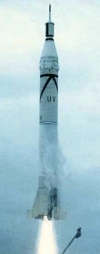
|
Explorer
2
Explorer II
EXPLR2 |
Explorer 2 was an exact
duplicate of Explorer 1. The launch of Explorer 2 atop
a Jupiter-c rocket failed due to a failure in its 4th
stage and the satellite did not reach orbit. |
Mar
3rd 1958 |
14,5
kg |
 This recording
of the launch of Explorer 2 is from vinyl no. 3 which
was included in the Italian Enciclopaedia L置omo e lo
spazio (The man and the space) issued 1965 by Fratelli
Fabbri. Digitized and kindly provided by Federico Manzini. This recording
of the launch of Explorer 2 is from vinyl no. 3 which
was included in the Italian Enciclopaedia L置omo e lo
spazio (The man and the space) issued 1965 by Fratelli
Fabbri. Digitized and kindly provided by Federico Manzini.
|
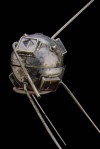
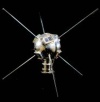


|
Vanguard
1
TV-4
1958 Beta 2
#00005
(1958-002B) |
 This
is the oldest man-made satellite which is still in orbit.
It is expected to last about another 190 years before
it finally decays. This spherical Navy test satellite
has a diameter of 16cm and was launched by a Vanguard
3-stage rocket into an elliptical orbit with an inclination
of 34,4 degrees, a perigee of 640 km and an apogee of
4020 km. The satellite had 2 power sources: the first
transmitter operated from a mercury cell supply and
had a life time of 3 weeks. Thanks to the fact that
this satellite was the first using solar cells the second
transmitter operated 6 years and 3 months. On February
21st 1965 it was declared to
be no more recognizable as the signal strength had declined
almost to zero. The output power of the transmitters
was 100mW (on 108.0 MHz) and 50mW (on 108.3 MHz) respectively.
The antenna system was comprised of 6 whip elements
each 30cm long. They made one turnstile antenna and
a dipole. The telemetry transmitted was the package
temperature indicated by the difference between the
two transmitter frequencies. Therefore, the recordings
were made with the receiver Beat Frequency Oscillator
(BFO) turned on in order to produce an audible tone
heard in the recordings. Thanks for the audio-file to
Roy W0SL. This
is the oldest man-made satellite which is still in orbit.
It is expected to last about another 190 years before
it finally decays. This spherical Navy test satellite
has a diameter of 16cm and was launched by a Vanguard
3-stage rocket into an elliptical orbit with an inclination
of 34,4 degrees, a perigee of 640 km and an apogee of
4020 km. The satellite had 2 power sources: the first
transmitter operated from a mercury cell supply and
had a life time of 3 weeks. Thanks to the fact that
this satellite was the first using solar cells the second
transmitter operated 6 years and 3 months. On February
21st 1965 it was declared to
be no more recognizable as the signal strength had declined
almost to zero. The output power of the transmitters
was 100mW (on 108.0 MHz) and 50mW (on 108.3 MHz) respectively.
The antenna system was comprised of 6 whip elements
each 30cm long. They made one turnstile antenna and
a dipole. The telemetry transmitted was the package
temperature indicated by the difference between the
two transmitter frequencies. Therefore, the recordings
were made with the receiver Beat Frequency Oscillator
(BFO) turned on in order to produce an audible tone
heard in the recordings. Thanks for the audio-file to
Roy W0SL.
|
Mar
17th
1958 |
1.5
kg |
 This
recording of the countdown and launch of Vanguard 1
is from vinyl no. 2 which was included in the Italian
Enciclopaedia L置omo e lo spazio (The man and the space)
issued 1965 by Fratelli Fabbri. Digitized and kindly
provided by Federico Manzini. This
recording of the countdown and launch of Vanguard 1
is from vinyl no. 2 which was included in the Italian
Enciclopaedia L置omo e lo spazio (The man and the space)
issued 1965 by Fratelli Fabbri. Digitized and kindly
provided by Federico Manzini.
|
 This
recording of Vanguard 1 while it was in its 7th
orbit. It is from vinyl no. 3 which was included in
the Italian Enciclopaedia L置omo e lo spazio (The man
and the space) issued 1965 by Fratelli Fabbri. Digitized
and kindly provided by Federico Manzini. This
recording of Vanguard 1 while it was in its 7th
orbit. It is from vinyl no. 3 which was included in
the Italian Enciclopaedia L置omo e lo spazio (The man
and the space) issued 1965 by Fratelli Fabbri. Digitized
and kindly provided by Federico Manzini.
|
 This recording
of Vanguard I was done while it was battery powered
and kindly provided by Dick W4PUJ/SK. This recording
of Vanguard I was done while it was battery powered
and kindly provided by Dick W4PUJ/SK.
|
 This recording
of Vanguard I was done while it was solar powered and
kindly provided by Dick W4PUJ/SK. This recording
of Vanguard I was done while it was solar powered and
kindly provided by Dick W4PUJ/SK.
|
 This recording
of Vanguard I was done after it was already 3 months
in operation and kindly provided by Dick W4PUJ/SK. This recording
of Vanguard I was done after it was already 3 months
in operation and kindly provided by Dick W4PUJ/SK.
|
 Vanguard
1 transmitted until February 21st
1965. This recording of Vanguard I was done after it
was already 1 year in operation and kindly provided
by Dick W4PUJ/SK. Vanguard
1 transmitted until February 21st
1965. This recording of Vanguard I was done after it
was already 1 year in operation and kindly provided
by Dick W4PUJ/SK.
|
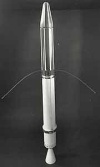 |
Explorer
3
Explorer III
1958 Gamma 1
#00006
(1958-003A) |
Explorer 3 was launched
by the US army from Cape Canaveral on a Juno launch
vehicle into an elliptical orbit with an apogee of 2809
km and a perigee 195 km.
Explorer III was spin stabilized
and its payload consisted of a cosmic ray counter (a
Geiger-Mueller tube), and a micrometeorite detector
(erotion gauge). The satellites decayed after 93 days
of operation on June 27th 1958. |
Mar
26th 1958 |
14.1
kg |
 This recording
of Explorer III was kindly provided by Dick W4PUJ/SK. This recording
of Explorer III was kindly provided by Dick W4PUJ/SK.
|
 This
recording of Explorer 3 is from vinyl no. 3 which was
included in the Italian Enciclopaedia L置omo e lo spazio
(The man and the space) issued 1965 by Fratelli Fabbri.
Digitized and kindly provided by Federico Manzini. This
recording of Explorer 3 is from vinyl no. 3 which was
included in the Italian Enciclopaedia L置omo e lo spazio
(The man and the space) issued 1965 by Fratelli Fabbri.
Digitized and kindly provided by Federico Manzini.
|



|
Sputnik
3
Sputnik III
Object D
#00008
(1958-004B) |
 Sputnik
3 was conically shaped and 3.57m long. It had 12 scientific
instruments and several radio systems. Enclosed audio
file was recorded at 20.005 MHz and kindly provided
by Sven Grahn. Sputnik
3 was conically shaped and 3.57m long. It had 12 scientific
instruments and several radio systems. Enclosed audio
file was recorded at 20.005 MHz and kindly provided
by Sven Grahn.
|
May
15th 1958 |
1327
kg |
 This
recording of Sputnik 3 is from vinyl no. 6 which was
included in the Italian Enciclopaedia L置omo e lo spazio
(The man and the space) issued 1965 by Fratelli Fabbri.
Digitized and kindly provided by Federico Manzini. This
recording of Sputnik 3 is from vinyl no. 6 which was
included in the Italian Enciclopaedia L置omo e lo spazio
(The man and the space) issued 1965 by Fratelli Fabbri.
Digitized and kindly provided by Federico Manzini.
|
 |
Explorer
4
Explorer IV
#00009
(1958-005A) |
Explorer
4 was a cylindrically shaped satellite instrumented
to make the first detailed measurements of charged particles
(protons and electrons) trapped in the terrestrial radiation
belts. It was launched into an elliptical low earth
orbit with an apogee of 2220 km and a , perigee of 262
km. Explorer 4 decayed after 454 days on October 23rd
1959. |
Jul
26th 1958 |
25.5
kg |
  These
two recordings of Explorer IV were kindly provided by
Dick W4PUJ/SK. These
two recordings of Explorer IV were kindly provided by
Dick W4PUJ/SK.
|
 This
recording of Explorer 4 is from vinyl no. 6 which was
included in the Italian Enciclopaedia L置omo e lo spazio
(The man and the space) issued 1965 by Fratelli Fabbri.
Digitized and kindly provided by Federico Manzini. This
recording of Explorer 4 is from vinyl no. 6 which was
included in the Italian Enciclopaedia L置omo e lo spazio
(The man and the space) issued 1965 by Fratelli Fabbri.
Digitized and kindly provided by Federico Manzini.
|
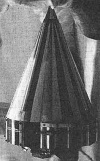
|
Pioneer
3
Pioneer III
#00111
(1958-008A) |
Pioneer 3 was a spin
stabilized spacecraft launched by the U.S. Army Ballistic
Missile agency in conjunction with NASA. The spacecraft
failed to go past the Moon and into a heliocentric orbit
as planned. Instead it reached an altitude of 102360
km before falling back and re-entering Earth's atmosphere.
It finally burned up over Africa on December 7th
at approximately 19:51 UTC.
The revised spacecraft
objectives were to measure radiation in the outer Van
Allen belt area using Geiger-Mueller tubes and to test
the trigger mechanism for a lunar photographic experiment.
A transmitter with a mass of 0.5 kg delivered a phase-modulated
signal at a frequency of 960.05 MHz. The total effective
radiated power was 0.18 W. |
Dec
6th 1958 |
5.9
kg |
 This
recording from Dick W4PUJ/SK is most likely not from
Pioneer 3 but most likely from Pioneer 1. This
recording from Dick W4PUJ/SK is most likely not from
Pioneer 3 but most likely from Pioneer 1.
|

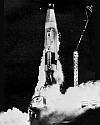
|
SCORE
Project Score
Chatterbox
#00010
(1958-006A) |
Project Score (Signal
Communication by Orbiting Relay Equipment) was the first
American communications satellite which was launched
from Cape Canaveral using an Atlas B missile. The entire
rocket was placed into low earth orbit (apogee 1480
km, perigee 177 km).
SCORE was an Advanced Research
Project Agency (ARPA) project carried out by the Signal
Corps with the Air Force providing the Atlas launching
vehicle.
The total weight of the satellite was 3980
kg as it included the rocket, the payload itself had
a weight of 68 kg.
The low earth orbit limited the
life expectancy of the satellite to only 2 to 3 weeks,
thus also limiting opportunities for realtime relay
between two ground stations. Therefore, a storeandforward
mode was added by including a tape recorder, which also
gave the satellite a worldwide broadcast capability.
There were actually 2 identical communications repeater
terminals integrated into the fairing pods of the missile
and the spacecraft's body acting as an antenna. The
redundancy proved to be a good idea as no modulation
was received on the carrier wave from experiment package
no. 1 which was transmitting at 150 MHz.
However
experiment package no. 2 transmitted on 132 MHz properly
: voice and teletype messages were sent and returned
in real time, and also from its experiment tape recorder.
This tape recorder was loaded with new material 28 times
before it finally failed due to battery depletion. The
132 MHz all vacuum tubes transmitter had an 8-W output.
An additional tracking beacon operated at 108 MHz.
Project Score's actual performance was nominal with
experiment operation for 12 days, planned orbit lifetime
20 days, actual orbit lifetime 35 days. |
Dec
18th 1958 |
3980
kg |
 This
recording of the launch of SCORE and part of the speech
of President Eisenhower is from vinyl no. 5 which was
included in the Italian Enciclopaedia L置omo e lo spazio
(The man and the space) issued 1965 by Fratelli Fabbri.
Digitized and kindly provided by Federico Manzini. This
recording of the launch of SCORE and part of the speech
of President Eisenhower is from vinyl no. 5 which was
included in the Italian Enciclopaedia L置omo e lo spazio
(The man and the space) issued 1965 by Fratelli Fabbri.
Digitized and kindly provided by Federico Manzini.
|
 Score
was the world's first satellite to broadcast voice including
a Christmas greeting from President Dwight D. Eisenhower.
His full message was: "This is the President of
the United States speaking. Through the marvels of scientific
advance, my voice is coming to you from a satellite
circling in outer space. My message is a simple one.
Through this unique means I convey to you and all mankind
America's wish for peace on earth and good will to men
everywhere." The transmission took place on December
19th 1958 at 20:15 UTC on 132.435
MHz. Score
was the world's first satellite to broadcast voice including
a Christmas greeting from President Dwight D. Eisenhower.
His full message was: "This is the President of
the United States speaking. Through the marvels of scientific
advance, my voice is coming to you from a satellite
circling in outer space. My message is a simple one.
Through this unique means I convey to you and all mankind
America's wish for peace on earth and good will to men
everywhere." The transmission took place on December
19th 1958 at 20:15 UTC on 132.435
MHz.
|
 This
recording of the tracking transmitter of Project Score
was kindly provided by Dick W4PUJ/SK. This
recording of the tracking transmitter of Project Score
was kindly provided by Dick W4PUJ/SK.
|
 This
audio recording was apparently in a lab where people
were receiving the signals of Project Score and was
kindly provided by Dick W4PUJ/SK. This
audio recording was apparently in a lab where people
were receiving the signals of Project Score and was
kindly provided by Dick W4PUJ/SK.
|
 This
recording of the signal of Project Score contains stored
voice and was kindly provided by Dick W4PUJ/SK. This
recording of the signal of Project Score contains stored
voice and was kindly provided by Dick W4PUJ/SK.
|
 This
recording of the teletype signal of Project Score was
kindly provided by Dick W4PUJ/SK. This
recording of the teletype signal of Project Score was
kindly provided by Dick W4PUJ/SK.
|

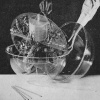
|
Vanguard
2
Vanguard II
#00011
(1959-001A) |
Vanguard
2 was an Earth Science satellite built and launched
from Cape Canaveral into an elliptical orbit with an
apogee of 3320 km and a perigee of 559 km.
The
mission of the 50cm spherical and spin stabilized satellite
was to measure cloud distributions.
Equipped with
infrared scanning devices to provide crude mapping of
the Earth's cloud cover and a tape recorder to store
the information Vanguard 2 made 211 orbits and and was
successfully interrogated 155 times to release the stored
information.
Radio communication was provided by
a 1 W, 108.03 MHz telemetry transmitter and a 10 mW,
108 MHz beacon transmitter that sent a continuous signal
for tracking purposes.
Both transmitters operated
for 19 days until the mercury batteries were drained. |
Feb 17th
1959 |
9.8 kg |


|
Explorer
6
Explorer VI
Able 3
S 2
#00015
(1959-004A) |
Explorer 6 was launched
by USA from Cape Canaveral on Thor-Able launch vehicle
into a highly elliptical orbit with an apogee of 41900
km and a perigee of 237 km. The mission of this small,
spheroidal satellite was to study trapped radiation
of various energies, galactic cosmic rays, geomagnetism,
radio propagation in the upper atmosphere, as well as
the flux of micro-meteorites. It also tested a scanning
device designed for photographing the earth's cloud
cover.
Each experiment except the television scanner
had two outputs, digital and analog. A UHF transmitter
was used for the digital telemetry and the TV signal.
Two VHF transmitters were used to transmit the analog
signal. The VHF transmitters were operated continuously.
The UHF transmitter was operated for only a few hours
each day.
Four solar cell paddles mounted near
its equator recharged the storage batteries while in
orbit. Only 3 of the paddles were deployed. The expected
lifetime was 1 year, the actual operation was 2 months. |
Aug
7th 1959 |
64.4
kg |
 This
recording of Explorer VI was kindly provided by Dick
W4PUJ/SK. This
recording of Explorer VI was kindly provided by Dick
W4PUJ/SK.
|

|
Discoverer
5
KH-1 9002
#00018
(1959-005A) |
 This recording
from a Discoverer satellite, possibly from Discoverer
5 or Discoverer 6, was kindly provided by Dick W4PUJ/SK.
Discoverer 5 decayed on Sept. 28th
1959. The Discoverer satellites were part of the Corona
program, the first series of US imaging spy satellites.
Each satellite carried a single panoramic camera and
a single return vehicle. This recording
from a Discoverer satellite, possibly from Discoverer
5 or Discoverer 6, was kindly provided by Dick W4PUJ/SK.
Discoverer 5 decayed on Sept. 28th
1959. The Discoverer satellites were part of the Corona
program, the first series of US imaging spy satellites.
Each satellite carried a single panoramic camera and
a single return vehicle.
|
Aug 13th
1959 |
640 kg |

|
Discoverer
6
KH-1 9003
#00019
(1959-006A) |
 This recording
from a Discoverer satellite, possibly from Discoverer
5 or Discoverer 6, was kindly provided by Dick W4PUJ/SK.
Discoverer 6 (also called Keyhole KH-1 9003) decayed
on Oct. 20th 1959. This recording
from a Discoverer satellite, possibly from Discoverer
5 or Discoverer 6, was kindly provided by Dick W4PUJ/SK.
Discoverer 6 (also called Keyhole KH-1 9003) decayed
on Oct. 20th 1959.
|
Aug 19th
1959 |
783 kg |


|
Vanguard
3
Vanguard III
#00020
(1959-007A) |
Vanguard
3 ( the Vanguard TV4 Backup) was launched by a Vanguard
rocket from the Eastern Test Range at Cape Canaveral
into a geocentric orbit with an apogee of 3744 km and
an perigee of 512 km. The objectives of the flight were
to measure the earth's magnetic field, the solar X-ray
radiation and its effects on the earth's atmosphere,
and the near-earth micro-meteoroid environment. Instrumentation
included a proton magnetometer, X-ray ionization chambers,
and various micro-meteoroid detectors.
Data transmission
stopped after 84 days of operation on December 11th
1959.Vanguard 3 has an expected orbital lifetime of
300 years. |
Sept
18th 1959 |
22.7
kg |
 This 13
minutes audio file documents the successful launch campaign
of Vanguard III. You can hear the countdown to the launch
starting at T-330 seconds, the launch itself and then
the later phases: 1st stage
burnout at T+148 seconds, 2nd
stage burnout at T+265 seconds and finally the 3rd
stage ignition at T+550 seconds. This recording was
kindly provided by Dick W4PUJ/SK. This 13
minutes audio file documents the successful launch campaign
of Vanguard III. You can hear the countdown to the launch
starting at T-330 seconds, the launch itself and then
the later phases: 1st stage
burnout at T+148 seconds, 2nd
stage burnout at T+265 seconds and finally the 3rd
stage ignition at T+550 seconds. This recording was
kindly provided by Dick W4PUJ/SK.
|

|
Explorer
7
Explorer VII
S 1A
#00022
(1959-009A) |
Explorer
7 was launched by USA on a Juno launch vehicle from
Cape Canaveral into an elliptical low earth orbit with
an apogee of 1080 km and a perigee of 553 km. The primary
mission of this satellite was to measure solar X-ray
and Lyman-alpha flux, trapped energetic particles, and
heavy primary cosmic rays (Z>5). Secondary objectives
included collecting data on micro-meteoroid penetration
and molecular sputtering and studying the earth-atmosphere
heat balance. The spin-stabilized satellite was powered
by 3000 solar cells and 15 NiCd batteries. It transmitted
telemetry on 20 MHz (1 Watt into 2 crossed dipoles)
and on 108 MHz a tracking beacon signal. Useful real-time
data were transmitted from its launch through February
1961 and intermittently until August 24th
1961. The original expected lifetime was 20 years. |
Oct
13th 1959 |
41.5
kg |
 This recording
of Explorer VII was kindly provided by Dick W4PUJ/SK. This recording
of Explorer VII was kindly provided by Dick W4PUJ/SK.
|
 This
recording of the Explorer 7 is from vinyl no. 9 which
was included in the Italian Enciclopaedia L置omo e lo
spazio (The man and the space) issued 1965 by Fratelli
Fabbri. Digitized and kindly provided by Federico Manzini. This
recording of the Explorer 7 is from vinyl no. 9 which
was included in the Italian Enciclopaedia L置omo e lo
spazio (The man and the space) issued 1965 by Fratelli
Fabbri. Digitized and kindly provided by Federico Manzini.
|
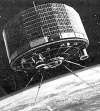


|
TIROS
I
TIROS 1
TIROS A
#00029
(1960-002B) |
TIROS 1
(Television and InfraRed Observation Satellite), the
first weather satellite, was designed to test the feasibility
of obtaining and using TV cloud-cover pictures from
satellites. It was launched on a Thor launcher from
Cape Canaveral into an almost circular orbit with an
apogee of 753 km and a perigee of 690 km. A single monopole
antenna for reception of ground commands extended out
from the top of the cover assembly. A pair of crossed-dipole
telemetry antennas (235 MHz) projected down and diagonally
out from the baseplate. Tiros-1 featured a beacon transmitter
on 108 MHz.
The satellite performed normally from
launch until June 15th 1960,
when an electrical power failure prohibited further
useful TV transmissions.  It
sent down more than 22952 pictures of cloud formations,
depicting the world as man had never seen it before.
Enclosed you see the first picture sent my TIROS 1 during
orbit #1 on April 1st 1960
and received by the tracking station Kaena Point on
Hawaii (second tracking station was in Fort Monmouth,
NJ, USA). It
sent down more than 22952 pictures of cloud formations,
depicting the world as man had never seen it before.
Enclosed you see the first picture sent my TIROS 1 during
orbit #1 on April 1st 1960
and received by the tracking station Kaena Point on
Hawaii (second tracking station was in Fort Monmouth,
NJ, USA). |
April
1st 1960 |
123
kg |
 This recording
of Tiros I was kindly provided by Dick W4PUJ/SK. This recording
of Tiros I was kindly provided by Dick W4PUJ/SK.
|
  These
recordings of the Tiros 1 satellite are from vinyl no.
10 which was included in the Italian Enciclopaedia L置omo
e lo spazio (The man and the space) issued 1965 by Fratelli
Fabbri. Digitized and kindly provided by Federico Manzini These
recordings of the Tiros 1 satellite are from vinyl no.
10 which was included in the Italian Enciclopaedia L置omo
e lo spazio (The man and the space) issued 1965 by Fratelli
Fabbri. Digitized and kindly provided by Federico Manzini
|
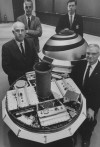

|
Transit
1B
#00031
(1960-003B) |
Navy Transit
1B was launched into orbit by Thor-Able-Star from Cape
Canaveral. The payload was a navigation experiment where
the receivers on Earth measured the Doppler shift of
the radio signal from the satellite. The ground stations
knew the satellite orbit data and thus could calculate
their position on Earth. Transit 1B also was first demonstrating
an engine restart in space. |
April
13th 1960 |
600
kg |
 This recording
is from vinyl no. 12 which was included in the Italian
Enciclopaedia L置omo e lo spazio (The man and the space)
issued 1965 by Fratelli Fabbri. Digitized and kindly
provided by Federico Manzini This recording
is from vinyl no. 12 which was included in the Italian
Enciclopaedia L置omo e lo spazio (The man and the space)
issued 1965 by Fratelli Fabbri. Digitized and kindly
provided by Federico Manzini
|
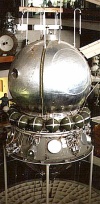
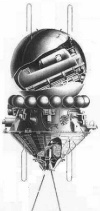
|
Sputnik
4
Sputnik IV
Korabl-Sputnik 1
#00034
( 1960-005A) |
Sputnik
4 (also called Korabl-Sputnik 1) was launched from former
U.S.S.R from Baykonur Cosmodrome into an elliptical
orbit with an apogee of 675 km and a perigee of 280
km.
This first of a series of spacecraft used to
investigate the means for manned space flight, contained
scientific instruments, a television system, and a self-sustaining
biological cabin with a dummy of a man. The spacecraft
was designed to study the operation of the life support
system and the stresses of flight. The spacecraft radioed
both extensive telemetry and prerecorded voice communications.
After four days of flight, the reentry cabin was separated
from its service module and retro-rockets were fired,
but because of an incorrect attitude the spacecraft
did not reenter the atmosphere. |
May
15th 1960 |
1477
kg |
 This recording
of Sputnik IV was kindly provided by Dick W4PUJ/SK. This recording
of Sputnik IV was kindly provided by Dick W4PUJ/SK.
|
 This recording
of Korabl-Sputnik 1 is from Bochum/Germany and was on
vinyl no. 12 which was included in the Italian Enciclopaedia
L置omo e lo spazio (The man and the space) issued 1965
by Fratelli Fabbri. Digitized and kindly provided by
Federico Manzini This recording
of Korabl-Sputnik 1 is from Bochum/Germany and was on
vinyl no. 12 which was included in the Italian Enciclopaedia
L置omo e lo spazio (The man and the space) issued 1965
by Fratelli Fabbri. Digitized and kindly provided by
Federico Manzini
|

|
MIDAS
2
AGENA A
#00043
(1960-006A) |
The MIDAS 2 (Missile
Defense Alarm System) satellite was an earth-orbiting
satellite designed to measure IR background and define
IR sources. The satellite included the second stage
of theAtlas 45D rocket. The chemical-battery powered
satellite transmitted for 2 days with the final transmission
on May 26th 1960. |
May
24th 1960 |
2300
kg |
 This recording
is from vinyl no. 13 which was included in the Italian
Enciclopaedia L置omo e lo spazio (The man and the space)
issued 1965 by Fratelli Fabbri. Digitized and kindly
provided by Federico Manzini This recording
is from vinyl no. 13 which was included in the Italian
Enciclopaedia L置omo e lo spazio (The man and the space)
issued 1965 by Fratelli Fabbri. Digitized and kindly
provided by Federico Manzini
|
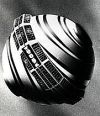
|
Transit
2A
#00045
(1960-007A) |
The Transit 2A spacecraft
was equipped with the following instruments: cosmic-noise
radiometer, transmitters, infrared scanner to measure
satellite rotation before despin was initiated and temperature
sensors. The power supply was a nickel-cadmium battery,
recharged by solar cells. The transmitters operated
at the following frequencies: 54, 162, 216, and 324
MHz. |
June
22nd 1960 |
101
kg |
 This recording
is from vinyl no. 20 which was included in the Italian
Enciclopaedia L置omo e lo spazio (The man and the space)
issued 1965 by Fratelli Fabbri. Digitized and kindly
provided by Federico Manzini This recording
is from vinyl no. 20 which was included in the Italian
Enciclopaedia L置omo e lo spazio (The man and the space)
issued 1965 by Fratelli Fabbri. Digitized and kindly
provided by Federico Manzini
|
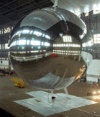 |
Echo
1 A
Echo B
Echo Balloon
#00049
(1960-009A) |
Echo 1 A
is sometimes also called Echo 1 however Echo 1 was actually
it predecessor which failed to launch on May 13th
1960. The Echo 1 A spacecraft was a 30.48-m-diameter
balloon of mylar polyester film 0.5 mil (0.0127 mm)
thick and was launched on a Thor-Delta rocket from Cape
Canaveral USA into an elliptical orbit with an apogee
of 1678 km and a perigee of 1519 km. The spacecraft
was designed as a passive communications reflector for
transcontinental and intercontinental telephone (voice),
radio, and television signals. Its surface was used
to reflect 960 MHz and 2390 MHz signals. It had 107.9
MHz beacon transmitters for telemetry purposes. These
transmitters were powered by five nickel-cadmium batteries
that were charged by 70 solar cells mounted on the balloon.
Because of the large area-to-mass ratio of the spacecraft,
data for the calculation of atmospheric density and
solar pressure could be acquired. The expected life
time was 1 year and it finally decayed on May 24th
1968. |
Aug
12th 1960 |
76
kg |
 This recording
of Echo 1 was kindly provided by Dick W4PUJ/SK. This recording
of Echo 1 was kindly provided by Dick W4PUJ/SK.
|
 These
recordings are from vinyl no. 14 which was included
in the Italian Enciclopaedia L置omo e lo spazio (The
man and the space) issued 1965 by Fratelli Fabbri. First
the launch of Echo 1 A is reported and then signals
received from Goldstone radiotelescope are provided.
Finally the voice of President Eisenhower can be heard.
Digitized and kindly provided by Federico Manzini These
recordings are from vinyl no. 14 which was included
in the Italian Enciclopaedia L置omo e lo spazio (The
man and the space) issued 1965 by Fratelli Fabbri. First
the launch of Echo 1 A is reported and then signals
received from Goldstone radiotelescope are provided.
Finally the voice of President Eisenhower can be heard.
Digitized and kindly provided by Federico Manzini
|

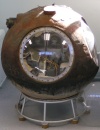
|
Sputnik
5
Sputnik V
Korabl-Sputnik 2
#00055
(1960-011A) |
Sputnik
5 (also called Korabl-Sputnik 2) was launched from former
U.S.S.R from Baykonur Cosmodrome into an elliptical
orbit with an apogee of 325 km and a perigee of 287
km.
This spacecraft was the second in a series of
spacecraft designed to further the development of an
Earth orbiting system for the planned manned space program.
The spacecraft carried two dogs, Strelka (eng.
arrow, deut. Pfeil) and Belka (eng. squirrel, deut.
Eichhörnchen), plus a grey rabbit, rats, mice,
flies, plants, fungi, microscopic water plants, and
seeds. Sputnik 5 returned telemetry and TV images showing
the dogs' physical condition. Reported transmission
frequencies were 19.995 MHz and 83 MHz.
After a
one day flight, the spacecraft and both dogs were successfully
recovered. Strelka (see right picture) and Belka became
the first living creatures to orbit the Earth and return
safely.
I am searching for sound files. Please send
them to  |
Aug 19th
1960 |
4600 kg |

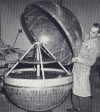
|
COURIER
1B
COURIER IB
#00058
(1960-013A) |
Courier 1B was a telecommunications
recording satellite launched by the US into an orbit
with an apogee of 1235 km and a perigee of 943 km. It
was a sphere with a diameter of 130cm and its surface
was covered with 19200 solar cells generating 62 Watts
which were stored in batteries. It could receive, record
on magnetic tape and re-broadcast voice and telegraph
messages at the rate of slightly more than 67000 words
a minute. COURIER IB communication system broke down
after 17 days operation. |
Oct
4th 1960 |
227
kg |
 This recording
of Courier I B was kindly provided by Dick W4PUJ/SK. This recording
of Courier I B was kindly provided by Dick W4PUJ/SK.
|
 This recording
is from vinyl no. 15 which was included in the Italian
Enciclopaedia L置omo e lo spazio (The man and the space)
issued 1965 by Fratelli Fabbri. Digitized and kindly
provided by Federico Manzini This recording
is from vinyl no. 15 which was included in the Italian
Enciclopaedia L置omo e lo spazio (The man and the space)
issued 1965 by Fratelli Fabbri. Digitized and kindly
provided by Federico Manzini
|

|
Vostok-1K
No.3
Sputnik 6
Korabl-Sputnik 3
#00065
(1960-017A) |
 This
Space Ship Vostok-1K No.3 carried two dogs, Pchelka
and Mushka, as well as a television system and other
scientific instruments. The flight lasted for one day.
The reentry was unsuccessful, because the cabin was
burned, precluding successful recovery and destroying
the two animals. This recording is from vinyl no. 17
which was included in the Italian Enciclopaedia L置omo
e lo spazio (The man and the space) issued 1965 by Fratelli
Fabbri. Digitized and kindly provided by Federico Manzini This
Space Ship Vostok-1K No.3 carried two dogs, Pchelka
and Mushka, as well as a television system and other
scientific instruments. The flight lasted for one day.
The reentry was unsuccessful, because the cabin was
burned, precluding successful recovery and destroying
the two animals. This recording is from vinyl no. 17
which was included in the Italian Enciclopaedia L置omo
e lo spazio (The man and the space) issued 1965 by Fratelli
Fabbri. Digitized and kindly provided by Federico Manzini
|
Dec 1st
1960 |
4563 kg |

|
Explorer
9
Explorer IX
S 56A
#00081
(1961-004A) |
Explorer
9 was the first in a series of 3.66 m inflatable spheres
to be successfully placed into orbit solely for the
determination of atmospheric densities.The two hemispheres
of aluminum foil were separated with a gap of Mylar
at the spacecraft's equator and served as the antenna.
A 136 MHz, 15 mW beacon was carried for tracking purposes,
but the beacon failed on the first orbit. |
Feb
16th 1961 |
36
kg |
 This
recording of the Explorer 9 is from vinyl no. 21 which
was included in the Italian Enciclopaedia L置omo e lo
spazio (The man and the space) issued 1965 by Fratelli
Fabbri. Digitized and kindly provided by Federico Manzini. This
recording of the Explorer 9 is from vinyl no. 21 which
was included in the Italian Enciclopaedia L置omo e lo
spazio (The man and the space) issued 1965 by Fratelli
Fabbri. Digitized and kindly provided by Federico Manzini.
|
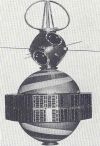
|
Transit
3B
LOFTI 1
#00087
(1961-007A) |
The Transit 3B spacecraft
(113kg) was launched together with a secondary satellite
LOFTI 1 (26kg). They were supposed to separate after
launch but this failed. On the picture to the left you
can see LOFTI 1 mounted on top of Transit 3B. The transit
3B satellite was powered by nickel-cadmium batteries
charged by 6600 solar cells. The orbit was more elliptical
than the planned circular orbit, which shortened the
satellite's lifetime to 37 days. |
Feb
22nd 1961 |
139
kg |
 This recording
is from vinyl no. 21 which was included in the Italian
Enciclopaedia L置omo e lo spazio (The man and the space)
issued 1965 by Fratelli Fabbri. Digitized and kindly
provided by Federico Manzini This recording
is from vinyl no. 21 which was included in the Italian
Enciclopaedia L置omo e lo spazio (The man and the space)
issued 1965 by Fratelli Fabbri. Digitized and kindly
provided by Federico Manzini
|

|
Vostok-3
No.1
Sputnik 9
Korabl-Sputnik 4
#00091
(1961-008A) |
 This
Space Ship Vostok-3 No.1 carried a dog named Chernuska
in space. Besides Chernuska also onboard was a dummy
cosmonaut, mice and a guinea pig. The flight lasted
for a single orbit, and a successful recovery was made.
Recording provided by Alois DL3PD/SK. This
Space Ship Vostok-3 No.1 carried a dog named Chernuska
in space. Besides Chernuska also onboard was a dummy
cosmonaut, mice and a guinea pig. The flight lasted
for a single orbit, and a successful recovery was made.
Recording provided by Alois DL3PD/SK.
|
Mar 9th
1961 |
4700 kg |

|
Explorer
11
S 15
#00107
(1961-013A) |
Explorer 11, also known
as S 15, was launched for the purpose of detecting the
sources of high-energy gamma rays. The spin stabilized
spacecraft achieved an orbit with an apogee of 1786
km, a perigee of 486 km, a period of 108.1 min, and
an inclination of 28.9 deg. Telemetry was provided only
in real time by two PM transmitters, since the onboard
tape recorder failed at launch. |
April
27th 1961 |
37.2
kg |
 This recording
of Explorer 11 was done by Heinz Kaminski in Bochum/Germany
and is from vinyl no. 26 which was included in the Italian
Enciclopaedia L置omo e lo spazio (The man and the space)
issued 1965 by Fratelli Fabbri. Digitized and kindly
provided by Federico Manzini This recording
of Explorer 11 was done by Heinz Kaminski in Bochum/Germany
and is from vinyl no. 26 which was included in the Italian
Enciclopaedia L置omo e lo spazio (The man and the space)
issued 1965 by Fratelli Fabbri. Digitized and kindly
provided by Federico Manzini
|



|
Transit
IV A
Transit 4A
#00116
(1961-015A) |
The primary
mission of the rather small spacecraft Transit IV A
was to serve as one of four operational navigational
satellites for use by ships and aircraft. The ground
stations knew the satellite orbit data and thus could
calculate their position on Earth. Transit 4A was the
first satellite using a radioisotope thermoelectric
generator (RTG) based on a nuclear power source using
Plutonium 238 for testing. Transit 4A tranmitted on
150.00 MHz and 400.00 MHz. |
June
29th 1961 |
79
kg |
 This recording
of Transit IV A is from vinyl no. 26 which was included
in the Italian Enciclopaedia L置omo e lo spazio (The
man and the space) issued 1965 by Fratelli Fabbri. Digitized
and kindly provided by Federico Manzini This recording
of Transit IV A is from vinyl no. 26 which was included
in the Italian Enciclopaedia L置omo e lo spazio (The
man and the space) issued 1965 by Fratelli Fabbri. Digitized
and kindly provided by Federico Manzini
|


|
Injun
1
Injun-SR-3
SOLRAD 3
GREB 3
#00117
(1961-015B) |
Injun 1 was
the first of a series of spacecraft designed and built
by the University of Iowa to study the natural and artificial
trapped radiation belts, auroras and airglow, and other
geophysical phenomena. It transmitted on 136.2 MHz.
Injun 1 was launched simultaneously with Transit 4A
and Greb 3. Transit 4A successfully separated from Injun
1, but Greb 3 (in the lower picture to the right on
top of Injun 1) did not. In the recording below you
can thus hear also the interference from the signal
of Injun 1 and GREB3. |
June
29th 1961 |
16
kg |
 This recording
of Injun 1 and GREB 3 is from vinyl no. 26 which was
included in the Italian Enciclopaedia L置omo e lo spazio
(The man and the space) issued 1965 by Fratelli Fabbri.
Digitized and kindly provided by Federico Manzini This recording
of Injun 1 and GREB 3 is from vinyl no. 26 which was
included in the Italian Enciclopaedia L置omo e lo spazio
(The man and the space) issued 1965 by Fratelli Fabbri.
Digitized and kindly provided by Federico Manzini
|

|
TIROS
3
TIROS-C
#00162
(1961-017A) |
TIROS 3 (Television and
InfraRed Observation Satellite) was a spin-stabilized
meteorological spacecraft designed to test experimental
television techniques and infrared equipment. TIROS
3 transmitted beacons on 108 .0 MHz and 108.03 MHz as
well as a 2 Watt TV signal in 235 MHz. In addition it
transmitted with 2 Watts on 237.8 MHz infrared pictures. |
July
12th 1961 |
129.3
kg |
 This recording
of TIROS 3 is from vinyl no. 26 which was included in
the Italian Enciclopaedia L置omo e lo spazio (The man
and the space) issued 1965 by Fratelli Fabbri. Digitized
and kindly provided by Federico Manzini This recording
of TIROS 3 is from vinyl no. 26 which was included in
the Italian Enciclopaedia L置omo e lo spazio (The man
and the space) issued 1965 by Fratelli Fabbri. Digitized
and kindly provided by Federico Manzini
|
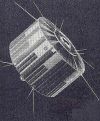
|
Transit
IV B
Transit 4B
#00202
(1961-031A) |
Transit 4B was a US Navy
navigation satellite launched by a Thor Able Star rocket
from Cape Canaveral. It carried a SNAP 3 nuclear power
source. Transit, one of the first operational satellite
systems, was also known as the Navy Navigation Satellite
(NNS), transmitted on two separate frequencies 149.99
and 399.97 MHz. |
Nov
15th 1961 |
86
kg |
 This recording
of Transit IV B is from vinyl no. 36 which was included
in the Italian Enciclopaedia L置omo e lo spazio (The
man and the space) issued 1965 by Fratelli Fabbri. Digitized
and kindly provided by Federico Manzini This recording
of Transit IV B is from vinyl no. 36 which was included
in the Italian Enciclopaedia L置omo e lo spazio (The
man and the space) issued 1965 by Fratelli Fabbri. Digitized
and kindly provided by Federico Manzini
|
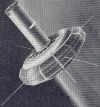
|
TRAAC
#00205
(1961-031B) |
The Transit Research
and Attitude Control (TRAAC) satellite was launched
by the US Navy along with Transit 4B. It was used to
test the feasibility of using the earth's gravitational
attraction to orient and stabilize a vehicle in space.
Its boom failed to extend but it transmitted data until
August 1962. |
Nov
15th 1961 |
91
kg |
 This recording
of TRAAC was done on Nov. 16th
1961 by the Observatorium in Bochum/Germany and is from
vinyl no. 36 which was included in the Italian Enciclopaedia
L置omo e lo spazio (The man and the space) issued 1965
by Fratelli Fabbri. Digitized and kindly provided by
Federico Manzini This recording
of TRAAC was done on Nov. 16th
1961 by the Observatorium in Bochum/Germany and is from
vinyl no. 36 which was included in the Italian Enciclopaedia
L置omo e lo spazio (The man and the space) issued 1965
by Fratelli Fabbri. Digitized and kindly provided by
Federico Manzini
|
Picture |
Object
name
#NORAD |
Description |
Launch
Date |
Weight |